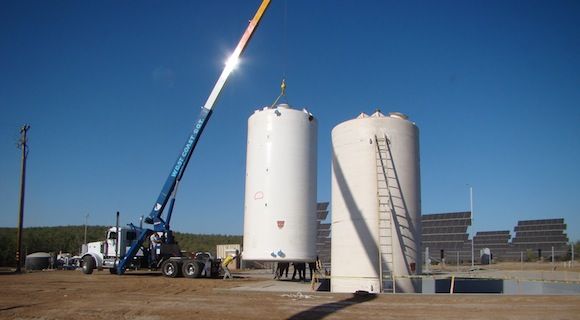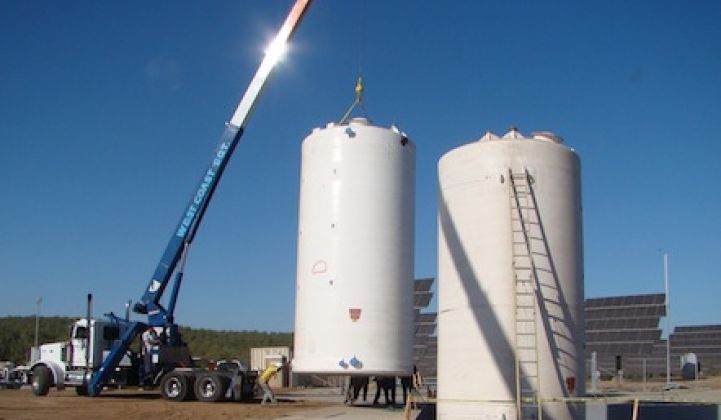Founded in 2008, California-based storage startup EnerVault has remained relatively quiet on its progress.
The flow battery market is, after all, defined more by grandiose claims from companies than by commercial projects in the ground.
But with $24.5 million in funding and an executive team hailing from SunPower, Tesla, and a range of battery, power plant engineering and fuel cell companies, EnerVault is now going public with its performance expectations.
"We've been particularly quiet about achievements," said Jim Pape, EnerVault's CEO and former president of residential and commercial solar at SunPower. "Part of that is our investors; part of that is that we don't want to put out statements we have to later jump over."
Here's a bold statement that EnerVault is now ready to make: The capital cost of its first commercial project, a 1-megawatt-hour system completing construction this week, will get the company close to beating DOE's cost targets (PDF) for commercial-scale redox flow batteries.
That "magic number" for capital cost is $250 per kilowatt-hour and a levelized cost of energy at $0.20 per kilowatt-hour. Jim Pape and EnerVault Chief Strategy Officer Craig Horne didn't provide specific data, but said the capital costs for current bids would be "well below" DOE's targets and their systems will "compete on an LCOE basis" with peaking natural gas plants in California.
The current project, located in Turlock, California, will provide 250 kilowatts of power for four hours to Pacific Gas & Electric. It was supported by the DOE's storage demonstration program under the stimulus package, which provided $4.7 million in assistance. The flow battery will be co-located with a PV system and a water pump.

A storage tank is installed at EnerVault's first commercial site in Turlock, California. Image credit: EnerVault
Flow batteries convert chemical energy into electricity by pumping electrolytes through a stack of electrochemical cells. EnerVault's "Engineered Cascade" technology arranges the stacks in a series of stages optimized to the electrolytes' state of charge, which the company says better utilizes the electrolytes by operating in a broader state-of-charge range. The initial commercial systems are expected to be more than 60 percent round-trip efficient, all losses included.
That's significantly lower than lithium-ion batteries, which offer efficiencies above 80 percent. Two of EnerVault's competitors developing aqueous-based electrolyte storage, Eos and Aquion Energy, claim 75 percent and 85 percent efficiencies, respectively.
EnerVault's flow battery technology uses iron-chromium electrolytes. Horne said the chemistry is safer and less acidic than vanadium ("you can spill it on your hand and it's a mild irritant") and less expensive than other chemistries being developed ("they are universally abundant elements").
However, reliability can be an issue due to the pumping systems needed to circulate electrolytes. That's why leading storage developer AES, a company open to a variety of technologies, says it prefers "sealed batteries" like lithium-ion and is still skeptical about new battery companies that don't have a "track record and balance sheet."
Horne said EnerVault's hydraulic pumping system will last "several thousand hours" and could be replaced within a matter of hours. He also said the low chemical aggressiveness of iron chromium will improve the lifespan of the battery. But that will only be proven when the Turlock project is commissioned and has been operating long enough to test those projections.
For the last year and a half, EnerVault has been running a 30-kilowatt demonstration system in its laboratory. Pape said the project was coming "within a few percent" of forecasted performance, giving the team confidence in its commercial project.
"We continue to match our models. We're really on the right track and we're going to be well below the DOE target" for cost, he said. "We see ourselves as an equivalent to a combustion turbine."
EnerVault's investor set includes materials company 3M and French oil & gas major Total, which Pape said have provided important technical and strategic advice for deployment.
Because of lower efficiencies, toxicity concerns and reliability issues, flow batteries are still a very small portion of the storage mix, however.
According to the Department of Energy's global energy storage database, there are 24.6 gigawatts of total storage projects in operation around the U.S. There are 28.8 megawatts of flow batteries in the U.S. pipeline -- but only 950 kilowatts in actual operation. Around the world, there are only 13 megawatts of flow batteries in operation.
While deployment is limited, flow batteries do offer longer, more consistent energy delivery -- a reason why startups and project developers are still attracted to the technology.
Utilities with a high sensitivity to technology risk may not be as enthusiastic. But Pape said the storage procurement process is becoming more favorable for flow batteries. Southern California Edison's recent 50-megawatt storage target includes technologies that can provide four hours of service, for example.
"A procurement system aligned with long-duration storage is a golden opportunity," he said. That sets the technology apart from lithium-ion, which companies with competing technologies say is better suited for frequency regulation and spinning reserve.
At 250 kilowatts of capacity, EnerVault's first commercial project is significantly smaller than some of the biggest vanadium flow batteries in operation today. But it's the biggest iron-chromium flow battery in the world "by a factor of ten" in energy delivery, said Horne.
In an industry with limited commercial deployment and field testing, EnerVault's flow battery will be another step toward better understanding the cost, reliability and energy delivery capabilities of the technology.



